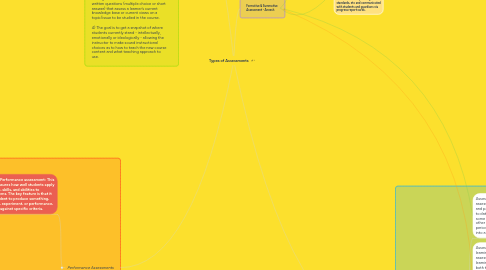
1. Diagnostic assessment Researched by Hang Jin
2. Performance Assessments
2.1. Victor Campo - Performance assessment: This assessment measures how well students apply their knowledge, skills, and abilities to authentic problems. The key feature is that it requires the student to produce something, such as a report, experiment, or performance, which is scored against specific criteria.
2.1.1. EXAMPLES
2.1.1.1. Examples of performance assessments include composing a few sentences in an open-ended short response, developing a thorough analysis in an essay, conducting a laboratory investigation, curating a portfolio of student work, and completing an original research paper.
2.2. Performance Based Assessment & Learning
2.2.1. Performance Assessment Defined Performance assessment involves the demonstration and application of knowledge, skills, and work habits through what is known as a performance task. It is important that the task be meaningful and engaging to students. Tasks built around student interests engage students and help them make connections to their personal lives. To make tasks meaningful to students, provide an authentic audience to whom they will present their knowledge. This gives them a purpose to apply effort to the task. When students perform tasks that are meaningful and engaging to them, they are able to take ownership of their learning and effectively work, either independently or in collaboration, depending on the requirement of the task. The core purpose of performance assessment is not to render an evaluation, but to improve student learning (Performance Assessment Series, Middle School Edition, 2001). This learning is accomplished when a student demonstrates his or her understanding AND communicates that understanding through written or oral presentations. Performance assessment can be used as either a formative or summative tool. For example, a performance assessment built around a complex reasoning task, such as problem solving or decision making, requires the synthesis of information from multiple sources. As students sort through the information and draw conclusions, a teacher can observe students’ reasoning skills in action and, if necessary, provide support to those who are struggling. This would be a type of formative assessment. The students’ final presentations, on the other hand, may be judged based on a rubric and given a score. That would be an example of using a performance task as a summative assessment.
3. What is diagnostic assessment? Informal Prior to instruction prior to instruction Assess prior knowledge, skills, preconceptions, etc. 1) Diagnostic assessment is given at the beginning of the course or the beginning of the unit/topic. 2) This assessment is used to collect data on what students already know about the topic. 3) Diagnostic assessments are sets of written questions (multiple choice or short answer) that assess a learner’s current knowledge base or current views on a topic/issue to be studied in the course. 4) The goal is to get a snapshot of where students currently stand - intellectually, emotionally or ideologically - allowing the instructor to make sound instructional choices as to how to teach the new course content and what teaching approach to use.
4. Examples: Like Background knowledge survey; ungraded quiz. 1) Stem class--The teacher surveys students's assumptions about the concepts that will be taught in the course. 2) Physic class-- Teacher uses a set of conceptual questions to assess students understanding of fundamental concepts at the start of the course. 3) Course with sensitive topics-- teachers may survey students in order to reveal assumptions that they may bring to controversial questions. 4 ) Course with group work-- The teacher surveys students prior experiences with group work and their attitudes towards group work, or conducts early term self-assessment.
5. Assessment of, as, and for learning - Lachelle Brooks
5.1. Assessment of learning: This type of assessment is to let teachers, students and parents know what has been learned to date, compares a student's learning to some type of criteria or standard that other students are meeting, is reported periodically and usually compiles data into a single score.
5.1.1. Assessment of learning: Report cards with GPA, ACT/SAT scores, graphs depicting the class "learning curve" and where students fall on the curve. It is a form of Summative Assessment
5.2. Assessments for learning: This type of assessment is for the learning evolution of both teachers and students. This assessment type checks learning and comprehension and allows for teachers to make modifications, or review, and for the student to 'fill in the gaps'. This focuses on improvement, provides detailed observations and feedback, and is not usually associated with the students graded evaluations.
5.2.1. Q&A, Quizzes, Ungraded performance assessments, any activities that are recorded for observation, but not graded. It is a form of Formative Assessment.
5.3. Assessments as learning: This type of assessment aims to help students grow self-sufficiently through "learning about learning"(CUW, 2013). It involves the students assessing themselves, with each other, or with the teacher's previously provided materials. "Students develop a sense of ownership and efficacy when they use teacher, peer and self-assessment feedback to make adjustments, improvements and changes to what they understand." (Government of Alberta, 2008)
5.3.1. Peer assessment, assessment surveys after group projects, self-checking and self-assessment, students providing assessments/feedback of the teacher's lessons/ability to teach said lessons, researching supplemental materials
